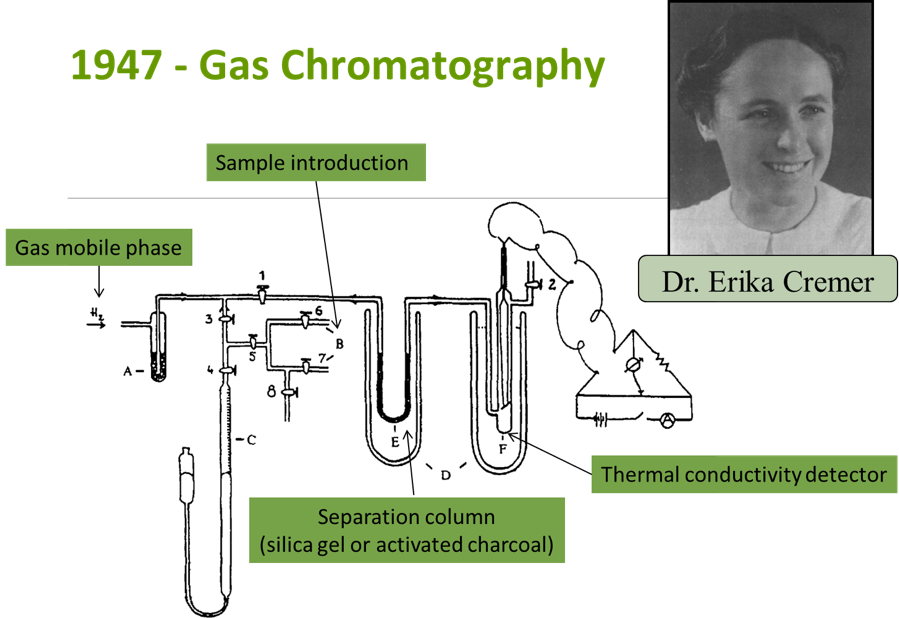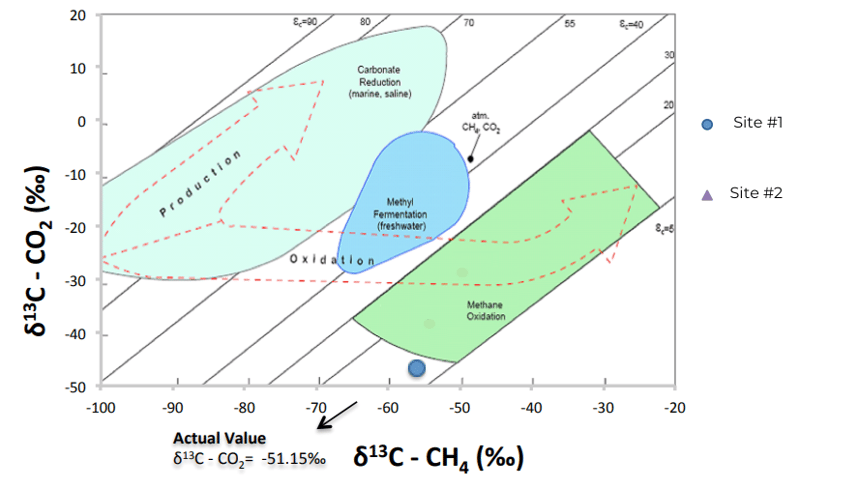Gas chromatography (GC) is an analytical technique that characterizes a chemical mixture by separation and identification of the chemical components. At Chemistry Matters, data generated from GC is used in arson investigations, biomonitoring, and environmental forensic investigations. Developing a concise timeline of the analytical developments in GC is important when considering historical chemical releases and potential culpability. However, as with many historical milestones, progress is made in parallel and significant achievements can be obscured by political and gender bias.
The invention of GC is generally credited to British scientists A. T. James and A. J. P. Martin for their 1952 paper on gas-liquid partition chromatography (James and Martin 1952). Their work gained the attention of the petroleum industry and led to the improvement and widespread adoption of modern GC. While the contribution of James and Martin is undeniable, there is another scientist that deserves recognition for her pioneering use of gas chromatography.
The recognition of Erika Cremer for the first reported use of gas chromatography has largely been overlooked due to circumstances of history. As a woman in the 1940s and 1950s, Dr. Cremer had an uphill battle. Although she had an esteemed PhD in Chemistry from the University of Berlin, the prejudice against female scientists prevented her from obtaining a professorship. During World War II, she was finally able to obtain a position at the University of Innsbruck in Austria, as most males were enlisted in the army. Erika Cremer’s first attempt to publish her theory of gas (adsorption) chromatography in 1944 was thwarted when her accepted manuscript was destroyed at the printers during an air-raid in Vienna. Her lab at the University was also destroyed during the war so she continued her research with PhD student Fitz Prior at a high school chemistry lab (Ettre 2008). Prior published his doctoral thesis in 1947 describing adsorption GC and demonstrating an important separation of acetylene and ethylene (Prior 1947). In 1951, Dr. Cremer published a series of papers on gas chromatography, but they were in relatively obscure German journals (Cremer and Müller 1951, Cremer and Müller 1951, Cremer and Prior 1951).
Although the work published by Dr. Cremer described a system that resembles today’s GC instruments (Figure 1), it was underappreciated by her German audience and unavailable to the US or UK due to language and political barriers. It wasn’t until well after the widespread accolades of James and Martin for the invention of GC, that the pioneering achievements of Erika Cremer were recognized (Bobleter 1996). Although a degree of prejudice against women in science continues today, I am reminded of the immense barriers women-scientists have overcome. I am thankful that I am a scientist during a time when information is easily shared on a global scale, and a time when women in science are being valued and celebrated!
Photo Credit: Figure 1: GC schematic without labels copied from Bobleter, O. (1996). Exhibition of the First Gas Chromatographic Work of Erika Cremer and Fritz Prior. Chromatographia, 43, 444-446. Picture copied from Bobleter, O. (1990). Professor Erika Cremer — A pioneer in gas chromatography. Chromatographia, 30(9),
Bobleter, O. (1996). "Exhibition of the First Gas Chromatographic Work of Erika Cremer and Fritz Prior." Chromatographia 43: 444-446.
Cremer, E. and R. Müller (1951). "Trennung und Bestimmung von Substanzen durch Chromatographie in der Gasphase." Zeitschrift für Elektrochemie und angewandte physikalische Chemie 55(3): 217-220.
Cremer, E. and R. Müller (1951). "Trennung und quantitative Bestimmung kleiner Gasmengen durch Chromatographie." Mikrochemie vereinigt mit Mikrochimica acta 36(1): 553-560.
Cremer, E. and F. Prior (1951). "Anwendung der chromatographischen Methode zur Trennung von Gasen und zur Bestimmung von Adsorptionsenergien." Zeitschrift für Elektrochemie und angewandte physikalische Chemie 55(1): 66-70.
Ettre, L. (2008). The Beginnings of Gas Adsorption Chromatography 60 Years Ago. LCGC North America. http://www.chromatographyonline.com/beginnings-gas-adsorption-chromatography-60-years-ago. 26: 48-60.
James, A. T. and A. J. P. Martin (1952). "Gas-liquid Partition Chromatography: the Separation and Micro-estimation of Volatile Fatty Acids from Formic Acid to Dodecanoic Acid." Biochemical Journal 50: 679-690.
Prior, F. (1947). Über die Bestimmung der Adsorptionswärmen von Gasen und Dämpfen, unter Anwendung der chromatographischen Methode auf die Gasphase Doctoral thesis, University of Innsbruck.



